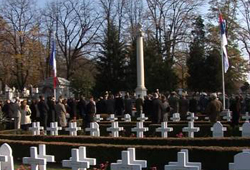Armistice Day
 Many local and foreign delegations laid wreaths at memorials dedicated to victims of World War I in our country to mark the Armistice Day. Armistice Day is marked with public events throughout the world, to commemorate November 11, 1918, when the Allied forces signed the armistice with Germany. The central state ceremony honoring the Armistice Day was held near the Crypt of Defenders of Belgrade in World War I, at the New Cemetery in Belgrade.
Many local and foreign delegations laid wreaths at memorials dedicated to victims of World War I in our country to mark the Armistice Day. Armistice Day is marked with public events throughout the world, to commemorate November 11, 1918, when the Allied forces signed the armistice with Germany. The central state ceremony honoring the Armistice Day was held near the Crypt of Defenders of Belgrade in World War I, at the New Cemetery in Belgrade.
Ceremony and wreath laying rites were led by the representative of the Serbian Government, State Secretary in the Ministry of Defense Igor Jovicic. He addressed those present saying that World War I ended on this day 93 years ago, thus replacing sufferings and violence with peace and reconstruction. " World War I was marked by extraordinary sacrifices and sufferings. This is the moment of remembrance and expression of our gratitude and respect for the Serbian soldiers. Although militarily and numerically weaker, they fought for freedom of their country with immense courage and faith in themselves," said Jovicic. These values, he added, are shared by today's officers and NCOs contributing to development of the modern Serbian Army. The ceremony was attended by ambassadors and defense envoys of countries that fought in WWI, including U.S. Ambassador Mary Warlick and German Ambassador Wolfram Maas.
Acting as an envoy of the Serbian President, the Serbian Army Chief of Staff, General Miloje Miletic laid a wreath at the monument of the Unknown Soldier on Mt. Avala. With the highest military honors, General Miletic paid tribute to victims, and he wrote in a memorial book that "as a country of peace, Serbia preserves the memory of the day the armistice was signed."
The First World War lasted from 1914 to 1918. The real causes of war were of economic and political nature, but the proximate trigger was the assassination of the heir to the Austro-Hungarian throne, Archduke Franz Ferdinand in Sarajevo, on June 28 1914. He was killed by Gavrilo Princip, a member of the revolutionary movement Mlada Bosna. The Austro-Hungarian invasion of Serbia initiated a series of alliances that started a chain reaction of declaration of war. Most world powers were involved in the war and assembled into two conflicting alliances: the Allies, centered around the Triple Entente, and the Central Powers. More than 70 million people were mobilized. During the war, over 15 million were killed, and 20 million wounded. After the war, the territory occupied by the Austro-Hungarian Empire was divided into new states, including the Kingdom of Serbs, Croats and Slovenians.
Source: glassrbije.org

